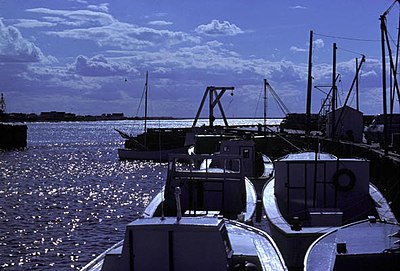geo.wikisort.org - River
Miramichi Bay is an estuary located on the west coast of the Gulf of St. Lawrence in New Brunswick, at the mouth of the Miramichi River.[1] Miramichi Bay is separated into the "inner bay" and the "outer bay", with the division being a line of uninhabited barrier islands which are continually reshaped by ocean storms. The largest of these islands is the uninhabited Portage Island, which was broken in two during a violent storm in the 1950s.[2] The islands provide some protection to the inner bay from ocean storms in the Gulf of St. Lawrence.[citation needed]
This article needs additional citations for verification. (March 2022) |

Miramichi Bay was named Golfe Saint Lunaire by Jacques Cartier in 1534.

The Inner Miramichi Bay, and the lower portions of its tributary rivers (including the Miramichi River), are parts of a drowned river valley system. Since deglaciation, sea level rise in Miramichi Bay has flooded the mouths of these rivers with saltwater. The flooded, meandering, ancient Miramichi river channel forms a navigable route through the Inner Bay for ocean-going ships entering the port at Miramichi (formerly the ports of Chatham and Newcastle). The inner bay measures only 4 m deep on average, with the navigation channel measuring only 6–10 m. Since dredging maintenance of this channel has stopped, the port is now only accessible to ships with a shallow draft.
The estuary is a highly dynamic environment, subject to high freshwater outflows during the spring freshet, low outflow and rising saltwater content during the summer period, fall ocean storms and nor'easters which reshape the barrier islands and the old river channel, and winter sea ice which encases the entire estuary. The shallow inner bay warms rapidly during summer. The diurnal tide cycle ranges only 1 m on average. Continued sea level rise is very slowly inundating adjacent low-lying areas and promoting rapid erosion of the low sandstone cliffs bordering the bay.
The estuary is significant in that it is a highly productive ecosystem, despite its relatively small size. The estuary receives the freshwater discharge from the Miramichi River and its tributaries, giving local waters somewhat lower salinity. Organic materials from the surrounding shorelines and inflowing rivers contribute, together with the warm water, to the bay's high productivity.

Recreational Uses
Recreational uses in Miramichi Bay include windsurfing, boating, kayaking[2] as well as fresh and salt water fishing.
Weather Patterns/Climate
The climate of Miramichi Bay is constituted as continental. As air mass moves from west to east from the Pacific to the Atlantic we see an average annual air temperature around 4.3 degrees Celsius. Precipitation is regular in this area, averaging about 160 days within the year and totaling around 995 mm. Water temperatures reach a maximum of 22 degrees Celsius during July and August, and freezing during November to December.[3]
Marine Ecosystem
Marine Life
Marine life includes harbour seals, herring gulls, the common tern (pictars to use the old Scottish word), the great blue heron (commonly called "crane" in the Miramichi), the common loon, and cormorants (called "black shag" locally), with kingfishers, plovers, snipe and killdeer along the shore. Fish living within the estuary that may commonly be fished for recreation also include cod, eel, striped bass, Atlantic salmon, and brook trout. Along the inner bay you may commonly find juvenile and adult lobster, and one the outer bay you will find crab, who are restricted to the deeper water.[4]
- Canada, National Research Council (1995). Water, Science and the Public: The Miramichi Ecosystem. NRC Research Press. p. 11. ISBN 978-0-660-15903-4.
- Canada, Environment and Climate Change (2014-10-27). "Portage Island National Wildlife Area Management Plan: chapter 3". www.canada.ca. Retrieved 2022-02-24.
- Canada, National Research Council (1995). Water, Science and the Public: The Miramichi Ecosystem. NRC Research Press. pp. 16–7. ISBN 978-0-660-15903-4.
- Canada, National Research Council (1995). Water, Science and the Public: The Miramichi Ecosystem. NRC Research Press. pp. 23–4. ISBN 978-0-660-15903-4.
На других языках
- [en] Miramichi Bay
[ru] Мирамиши (залив)
Мирамиши[1] (англ. Miramichi Bay) — залив на юго-востоке Канады, в западной части Залива Святого Лаврентия.Другой контент может иметь иную лицензию. Перед использованием материалов сайта WikiSort.org внимательно изучите правила лицензирования конкретных элементов наполнения сайта.
WikiSort.org - проект по пересортировке и дополнению контента Википедии